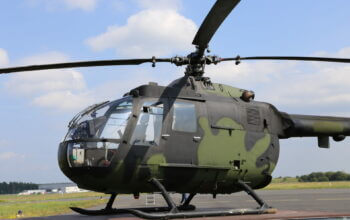Bell sold over 200 commercial aircraft in 2022 — a figure described as “remarkable” by the company’s president and CEO, Mitch Snyder.

“We had remarkable sales this year and we have been trying to ramp and trying to keep up with the commercial side of the business because it has been booming and the sales have been great,” he told reporters during a media briefing shortly after the company’s annual results were announced. “As we’re going forward, there is always a discussion of ‘Is there a recession/not a recession?’ But right now, we have not felt it in the order book coming to us, and so our commercial business is ramping and growing.”
The company also delivered 179 aircraft over the year, up from 156 in 2021. Snyder said the deliveries represented “an excellent effort” from Bell’s production staff given the supply chain challenges facing many companies at the moment.
“I think a lot of industries are learning where they may have sourced too much stuff in certain areas and then they couldn’t control their destiny,” said Snyder. “If you go to our Manufacturing Tech Center, you’ll see that we’ve decided to make sure that we were vertically integrated in a lot of areas, so we can control that. We can really go from raw material to product, as opposed to going through multiple supplliers or multiple processes to get there.”
Michael Thacker, executive VP of commercial business at Bell, said the company was seeing continued market recovery from 2020, with growth throughout 2021 and 2022. “We expect further growth in 2023, as well,” he said.
Thacker said sales activity was positive “across all regions and all segments,” with Bell adding customers that are new to aviation, as well as moving to the company from other manufacturers.
“For these, as well as existing Bell family members, we continue to expand the capability and coverage of our service network to ensure quality and timely support of customers wherever they operate,” he said.
Bell’s aftermarket business in 2022 reflected a growth in customer flight hours, with increased spares demand and “significant” repair and overhaul activity across the globe, said Thacker. He added that Bell plans to continue expanding its support capabilities, coverage and offerings in 2023.
Last year saw Bell introduce a new Executive Customer Advantage Plan option, designed for corporate/VIP customers. The plan is designed to protect direct maintenance costs and aircraft value for customers who fly under 200 hours each year.
“A VIP customer that’s operating less than 200 hours a year is going to have a different set of needs then a utility customer that’s operating 1,000 or more hours a year,” said Thacker. “When you look at those needs, we have tried to make sure we have support payment plans and packages that fit their needs and help level load their costs.”
In terms of regional activity, Bell “had a great year in Europe,” with solid sales and a “large wave” of customers who are new to the company. Thacker highlighted the success of the 505 in the continent, with 80 of the type now in operation there.
Asia-Pacific saw strong commercial activity and demand across the region, he said, highlighting Bell’s recent acquisition of Eagle Copters Maintenance as allowing the OEM to expand its support for customers in the region.
China continues to be an “incredibly underserved” market, said Thacker, adding that Bell continues to engage with partners and customers as the country opens up. However, he cautioned that development of that market remains “a long play, particularly in the current environment.”
Latin America produced over 50 orders for Bell in 2022, with the region ordering the most 412s of any in the world last year.
In terms of future product developments, Thacker said Bell is “actively engaged in developments that are appropriate for each of our products,” but the focus on the commercial side is to get the 525 certified and in the field, followed by kits to enable it to enter sectors beyond its initial utility/oil-and-gas configuration.
The type’s market entry may have been somewhat aided by its delayed certification, with the oil-and-gas market appearing to rebound after a prolonged downturn.
“We see that demand is coming back,” said Thacker. “There were a lot of aircraft kind of parked on the sidelines, and I would say our observation is that the bulk of that is back in operation. I think you’ll see that it’s good timing for us to come to market.”
Snyder said the certification of the 525 could herald the start of a “refresh” for the commercial line.
“I think what you’ll see is going forward is once the 525 gets [certified], we need to continue to work on kits and upgrades for the 525, [and then] you’re going to see a lot of new things being done on the rest of the commercial line as that investment starts working its way in there,” he said. “You’ll start to see a refresh coming on that side of the business.”
The first focus for new product developments would be safety, said Thacker.
“There are key things that can be hazardous in rotorcraft operations, so we’ll continue to put out aftermarket kits for things like . . . bird-strike resistant windshields, [and] continuing to look at ways that we can improve the pilot situational awareness for things like wire or ground strikes,” he said.
These would be provided as both aftermarket kits and as forward fit, he added.
Looking ahead at the evolving economic environment, Thacker said he sees the pricing environment continuing to increase.
“As inflation comes in, we all have to react to that,” he said. “What we’ve tried to do is make sure that we’re taking care of our business while we’re also trying to minimize the impact to our end customers, and try to walk that balance.”









